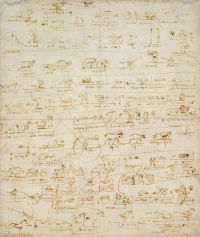Imagination and Invention Click on the thumbnails to explore the trail
Read more about this trail (expand)
The exercise of imaginative fantasy was as much an integral part of Leonardo’s mind as the discipline of scientific observation. For the artist, imagination was dependent upon an accurate understanding of observational input – a complete comprehension of the geometry of God’s design. Sensory impressions gained from observation were recombined by the artist’s ‘fantasia’ or imagination, to create new and credible forms

- Enlarge
- Zoom & explore
- The Royal Collection © 2005, Her Majesty Queen Elizabeth II
A sheet of puzzle writing, mainly in the form of pictographs c1495
Leonardo was an entertainer. He improvised songs and melodies and made up jokes, riddles, and pictographs - puzzles comprised of pictures and words to suggest words or phrases. These were probably welcome diversions for courtiers’ as a means of passing the time, not unlike crossword puzzles.
This sheet of pictographs can be seen as a sort of dictionary from which Leonardo could compose puzzles. The entire sheet is drawn in Leonardo’s characteristic mirror writing. Some of the pictograms are easy to decipher. In the centre of the second row from the top, two hands labelled in Italian due mani and two swags (feste) can be read to mean manifeste (shown).
Others link together to form phrases, such as in the third column beginning on the far right. Hill (colle) a frying pan (padella) and a figure with a clock over his face representing “fortune” can be read as col padella fortuna or colpa della fortuna (stroke of luck).
In the centre of the penultimate row Leonardo includes a pictogram for his own name – a lion in flames labelled lion arde with two tables, due tavole, or deschi, becomes Lionardeschi.
In Leonardo's words
Riddle: Much of the sea will escape toward the sky and will not come back for a long time
(Answer: the evaporation of water into clouds)
This sheet is one of a series of sheets of pictograms – word games comprised of tiny sketches and words or parts of words that can de deciphered to give a different word or a phrase.
The majority of the pictographs on this sheet are made up of animals and plants. Some involve only a picture, for example a female figure with a sail is fortuna (“fortune”). In most cases the picture is preceded or followed by a few letters, as a net followed by the letters nuta = retenuta (rete is Italian for “net”).
Leonardo has written a key under each picture in characteristic mirror writing which reads from right to left.
- Medium Pen and brown ink on white paper
- Size 30 x 25.3 cm
- Location The Royal Collection










